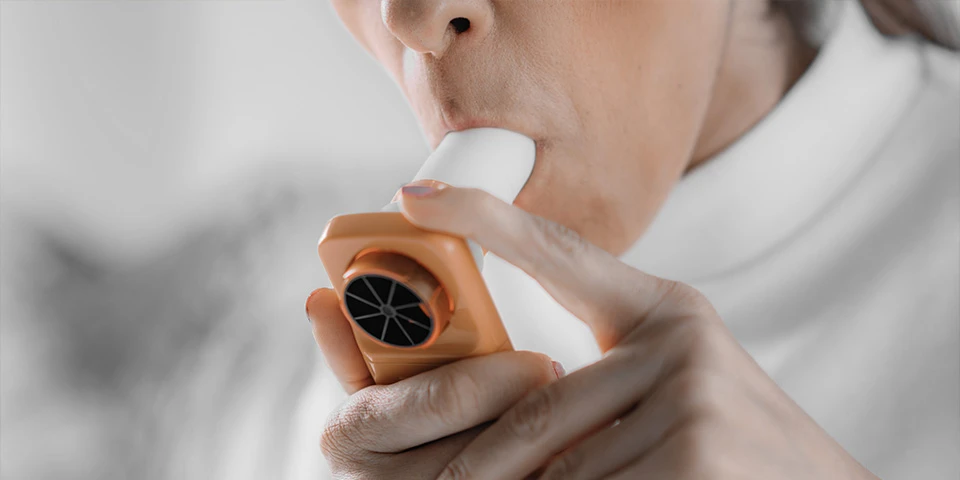Updated August 2024
Asthma is a chronic respiratory condition that can make physical activity challenging for many individuals. However, recent research highlights the significant benefits that tailored exercise programmes can offer to those living with asthma. A 2024 study has provided valuable insights into how different intensities of aerobic exercise can impact asthma management, revealing that moderate-intensity workouts, in particular, can lead to meaningful improvements in asthma control and quality of life. This article delves into the study’s findings and offers practical advice on designing safe, effective exercise programmes that help asthmatic clients achieve their fitness goals while managing their condition effectively.
The Study
A 2024 study explored the effects of moderate and vigorous-intensity aerobic exercise on asthma outcomes in adults. Conducted with 41 participants, the study revealed that moderate-intensity exercise, performed three times a week for 45 minutes, significantly improved asthma-related quality of life (AQLQ) and overall asthma control. The findings showed reduced airway inflammation, as evidenced by decreased sputum macrophage and lymphocyte counts. While vigorous-intensity exercise also had benefits, they were less clinically significant, highlighting the importance of intensity selection in exercise programmes for asthmatic individuals.
Designing Programmes
When working with asthmatic clients, it’s crucial we design exercise programmes that maximise benefits while minimising risks. The study provides valuable insights into how moderate-intensity aerobic exercise can be a cornerstone of these programmes. Here are key considerations:
- Start with an Assessment:
- Before beginning any exercise programme, assess the client’s asthma severity, current level of control, and physical fitness. This helps in tailoring the exercise plan to their specific needs.
- Focus on Moderate-Intensity Exercise:
- The study underscores the effectiveness of moderate-intensity aerobic activities, such as brisk walking, swimming, or cycling, which can improve asthma control and quality of life. Aim for 45 minutes of moderate exercise three times a week.
- Gradual Progression:
- Begin with low to moderate intensity and gradually increase the duration and intensity as the client becomes more comfortable and their asthma remains under control. Avoid sudden increases in intensity, which can trigger symptoms.
- Incorporate Warm-Ups and Cool-Downs:
- A proper warm-up is essential to prepare the respiratory system and reduce the risk of exercise-induced bronchoconstriction (EIB). Similarly, a gradual cool-down helps to bring the heart rate and breathing back to normal.
- Monitor Asthma Symptoms:
- Educate clients on recognising early signs of asthma exacerbation, such as shortness of breath, wheezing, or chest tightness. Equip them with an action plan for managing symptoms during exercise.

Exercise Intensity & Asthma Management
The study highlights important differences between moderate and vigorous-intensity exercise, both of which can benefit asthmatic clients, but with varying impacts on asthma control.
- Moderate-Intensity Exercise:
- This type of exercise, characterised by activities like brisk walking or steady cycling, was found to be particularly effective in improving AQLQ and reducing airway inflammation. It’s generally safer for clients with asthma, as it carries a lower risk of triggering EIB.
- Vigorous-Intensity Exercise:
- Activities such as running or high-intensity interval training (HIIT) can also be beneficial but require careful monitoring. While they can improve asthma control, the study found that these improvements were less clinically significant compared to moderate exercise. Vigorous activities should be introduced gradually and under close supervision.
- Personalisation is Key:
- Understanding how different intensity levels affect each client allows fitness professionals to create personalised exercise programmes. For clients who enjoy high-intensity workouts, ensuring they are well-managed and properly monitored is crucial.
Incorporating Aerobic Exercise into Asthma Treatment Plans
We play a vital role in incorporating exercise into the broader asthma management plan. Collaboration with healthcare providers is essential to ensure that exercise prescriptions align with the client’s medical treatment.
- Communication with Healthcare Providers:
- Work closely with the client’s healthcare team to understand their asthma management plan and how exercise fits into it. This ensures that the exercise programme complements other treatments, such as medication.
- Education and Empowerment:
- Educate clients about the benefits of regular aerobic exercise for asthma control. Empower them to take an active role in managing their condition through exercise, reinforcing the study’s findings on the importance of moderate-intensity activities.
- Regular Review and Adjustment:
- Periodically review the client’s progress and adjust the exercise programme as needed. This could involve increasing intensity as asthma control improves or modifying the programme if symptoms worsen.
Monitoring and Adjusting
Monitoring is a critical component of any exercise programme for asthmatic clients. It ensures that the client remains safe while achieving the benefits of regular physical activity.
- Use of Peak Flow Meters:
- Encourage clients to use peak flow meters before and after exercise to monitor lung function. This can help in detecting early signs of airway constriction and prevent exercise-induced asthma attacks.
- Symptom Tracking:
- Have clients keep a log of their symptoms during and after exercise sessions. This information can be invaluable in adjusting the exercise intensity or duration to avoid exacerbations.
- Emergency Preparedness:
- Ensure that clients have quick access to rescue inhalers during exercise sessions and are aware of how to use them. Being prepared for emergencies can significantly reduce the risk of severe asthma episodes.
- Adjusting Based on Environmental Factors:
- Environmental conditions such as cold air, high pollen counts, or pollution can exacerbate asthma symptoms. Adjusting the exercise plan to indoor activities on such days can help maintain consistency without compromising safety.
The 2024 study offers us valuable insights for working with asthmatic clients. By focusing on moderate-intensity aerobic exercise, understanding the impact of different exercise intensities, incorporating exercise into a comprehensive asthma treatment plan, and monitoring symptoms closely, we can design safe and effective programmes that enhance our clients’ quality of life. With the right approach, exercise can be a powerful tool in the management of asthma.
Reference
Valkenborghs, S. R., et al. (2024). Effects of Moderate- versus Vigorous-Intensity Exercise Training on Asthma Outcomes in Adults. Journal of Allergy and Clinical Immunology: In Practice. Click here to review the full research article
Work with Clients Who Have Medical Conditions
Are you a fitness professional looking to expand your expertise and make a real difference in your clients’ lives? The GP Exercise Referral Course from TRAINFITNESS is your pathway to becoming a specialist in working with clients who have chronic conditions like asthma. Recent studies have shown that tailored exercise programmes, especially those focused on moderate-intensity aerobic activities, can significantly improve asthma control and overall quality of life. By enrolling in this course, you’ll gain the skills and knowledge to create safe, effective exercise plans that help clients manage their conditions while achieving their fitness goals. Empower your clients with the benefits of exercise and elevate your career with this comprehensive qualification.
Exercise Referral Course – Distance Study

